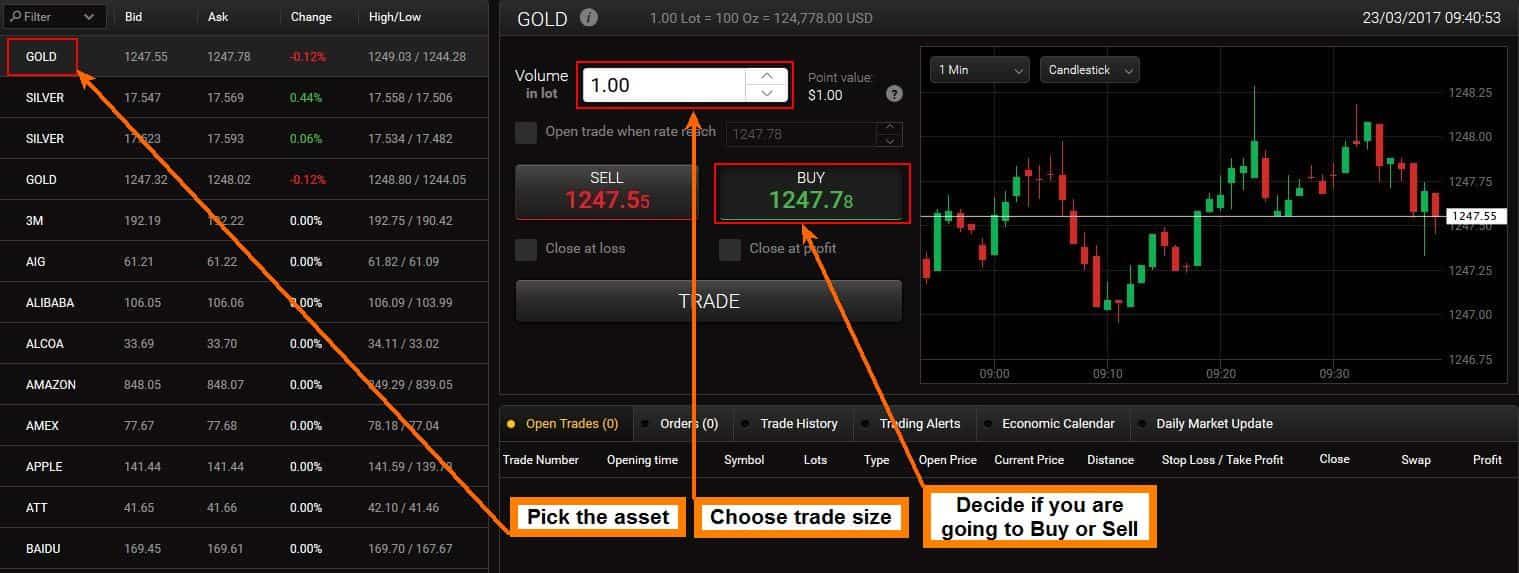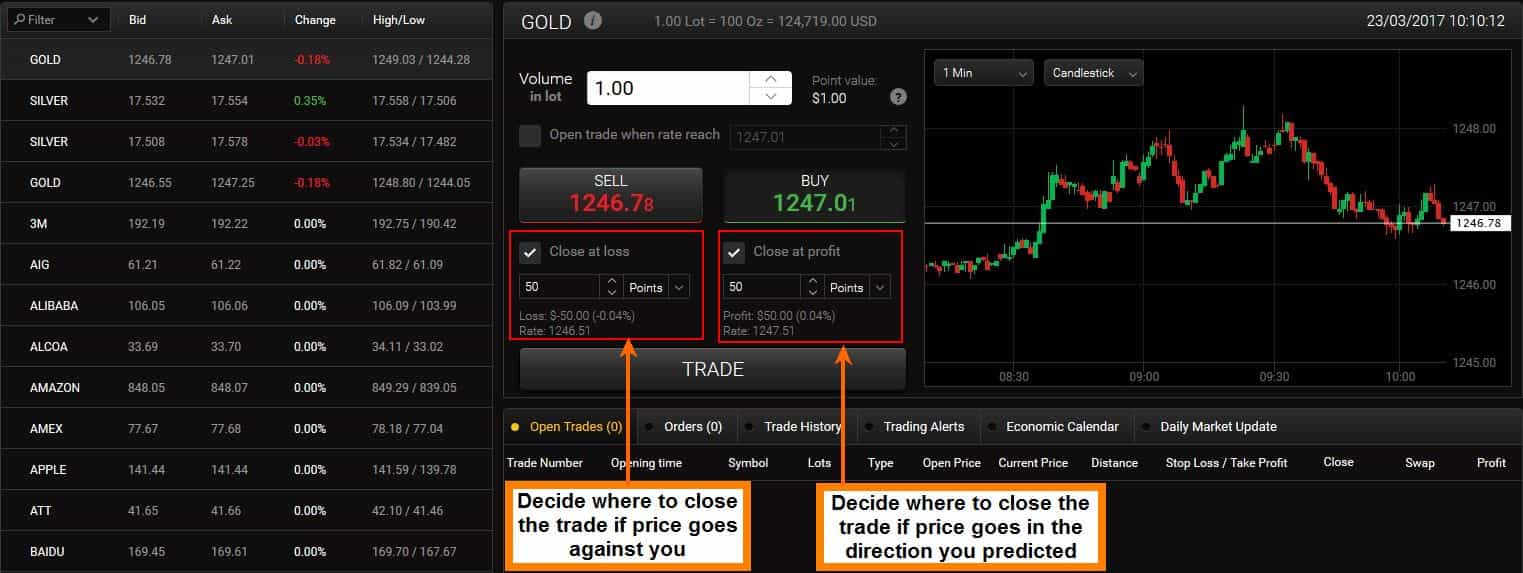What is a Contract For Difference? Trade CFD Explained!
“It is not the strongest or the most intelligent who will survive but those who can best manage change.” ― Leon C. Megginson
Change is a key element of trading! Trends change all the time and you cannot stick to one, thinking that it will go on forever. You have to be aware of all trading trends, including Binary Options, Forex and Contracts For Difference because… well, you’re a trader right? And I hear that The Trend Is Your Friend so let’s pay attention to the emerging CFD trend and let’s see how we can make some money out of it – after all, that’s the whole point of trading, isn’t it?
What is Online CFD Trading?
A Contract For Difference (CFD) is exactly what its name implies: you make a contract (trade) with your broker at a certain price and agree that at the contract’s end, you will receive or pay the difference between the opening value and closing value of the contract. So you make a contract for the difference between the trade’s Opening and Closing prices… hence, the name Contract for Difference.
A CFD trade involves two parties: a buyer and a seller. When you are the buyer, you will make a profit if the stock, commodity or whatever asset you are trading, increases in value, but if the price decreases, you will make a loss. When you are the seller, you will make a profit if the traded asset decreases in value by the end of the trade and you will make a loss if the asset increases in value.
CFD for Dummies
Translated into plain English: if you buy a CFD on Gold at the value of 1200 and by the time you close your trade, the price is higher, you’ve made a profit; if the price goes down, you lose. The profit or loss you make depends on how much the underlying asset moves. So in our example, a move up of 100 points in Gold will bring you more profit than a 50 points move up. A 100 points move down will make you a bigger loss than a 50 points move down.
The more price moves away from your opening price, the more you gain or lose. This is a key element of CFDs and is one of the main differences between CFD and Binary Options, but more on that later because now we are going to focus on the elements of a CFD trade – all you need to know before you can open a trade:
How does CFD Trading Work?
First things first: before opening a CFD trade, you will have to do some analysis to predict where price is going. Don’t just open trades left and right based on gut feeling. Follow a strategy, use risk management and never invest more than you are prepared to lose. But you’re all big boys and girls and you can take care of yourselves, so let’s get on with it. Check out the pic below for the steps to open a CFD trade:

Step One: Pick the asset
– self-explanatory, just select the asset you want to trade.
Step Two: Choose trade size
– pick how much you want to invest. When you fill in the “Volume” case, the “Point value” will be automatically displayed to the right (the placement and terms may differ, depending on your broker’s platform). The Point Value is a key element because it directly affects your profit and loss. In our example picture above, I’ve used a Volume of 1 Lot, which translates in $1.00 Point Value, meaning that for each Point price moves, I can win or lose $1.00.
Step Three: Decide if you are going to buy or sell.
Again, this is self-explanatory but the decision should be made after careful analysis, as I’ve already mentioned.
Step Four: Risk and Reward Management
(yup, this one has its own picture):

Keep in mind that different brokers have different platforms, so things may look different for you but the idea is the same: you need to define your Risk and Reward. You do this by using a Stop Loss and a Take Profit. Both will close the trade automatically if a certain profit or loss is reached. Example: Open a Buy at 1.2250, with a Stop Loss at 1.2200 and a Take Profit at 1.2300. If the price goes up and reaches your profit target (1.2300), your trade will be closed with a profit of 50 pips/points. If the price goes down and reaches your Stop Loss (1.2200), the trade will be closed with a loss of 50 pips/points.
Step Five
*this applies mostly if you didn’t use a Stop Loss or Take Profit*: Close the trade manually when you see fit but it is worth noting that even if you have used a Stop Loss and/or Take Profit, you can close the trade before either one is reached.
CFD Trading Brokers
At your convenience, we’ve included a list of all CFD Brokers. Make sure you only trade with a regulated broker!
Important Terms in CFD Trading
Investment amount/Trade size
The profit you make depends on the size of your investment so first, you will have to decide the size of your trade. The regular unit is the LOT but you can invest lower than one lot, depending on your broker. The size of the LOT differs depending on the asset: one LOT can be 100,000 USD (for currency trading), 100 Oz (for Gold), 5,000 Oz (for Silver), or 100 Shares (for Stocks).
For the sake of the example I will stick with currencies: if you buy 1 LOT EUR/USD it means you placed a 100K trade on that pair (you will not have to invest 100K because CFDs are traded on margin – meaning that you don’t have to come up with the entire investment amount). Your pip/point value changes depending on how many lots you buy. In our example, one pip is worth 10 USD, so if you buy EUR/USD at 1.1200 and close the trade at 1.1210, you’ve made 100 bucks (10 pips and each pip is 10 bucks). Don’t worry about these calculations because almost all CFD platforms will show you the pip value, calculated relative to your investment amount and the asset that you are trading.
Bid and Ask
CFD trades have two different prices, known as Bid and Ask. The Bid is the price you are getting if you are selling and the Ask is the price you will pay if you want to buy an asset. On all CFD platforms, you will see both the Bid (usually on the left side, in red) and Ask (usually on the right side, in Green) prices. Whenever you open a Sell trade you will use the Bid and when you open a Buy you will use the Ask, which takes us to the next element.
Spread
This is the difference between Bid and Ask. This is the broker’s profit and you will have to pay it every time you open a trade. Usually, the assets with a high trading volume will have a tighter spread than the more exotic ones.
Stop Loss and Take Profit
Apart from your trade size, these are the two most important tools for money management and should be used with caution. The Stop Loss is a level where you decide to close the trade if price moves against you and the Take Profit is a level where you decide to close it if the price moved in your favor. Both of them can be set before or after the trade is opened; they can also be modified. Example: You Buy Gold at 1200, with Taking Profit at 1250 and Stop Loss at 1150. If price touches Take Profit the trade will be closed with a profit of 50 pips and if price touches Stop-Loss, the trade will also be closed, with a loss of 50 pips. The actual money you make or lose depends on your pip value or in other words, trade size.
CFD Trading – Summary
– A CFD is designed to pay the difference between the price of the underlying asset at the beginning of the trade (Open) and price at the end of the trade (Close)
– When you open a CFD trade, you can choose Buy (Up) or Sell (Down)
– Placing a Buy trade is referred to as “going long”.
– Placing a Sell trade is referred to as “going short”
– A Buy (Long) trade will become profitable if the underlying asset (stocks, indices, commodities, currencies) will increase in value.
– A Sell (Short) trade will become profitable if the underlying asset (stocks, indices, commodities, currencies) will decrease in value.
– The more price moves in your direction the more money you can make
– The more price moves against your direction, the more money you can lose
– You can decide where you want your trade to be closed, for both winning and losing trades (Take Profit and Stop Loss).
– The amount of money you make or lose depends on your pip value. If your pip value is high, your risk and reward are also high (you can make a lot of money fast and you can lose a lot of money fast).
– You can close a CFD trade at any time, even if you are in profit or in loss
– A Buy trade is opened at Ask and a Sell trade is opened at Bid. The difference between the 2 is the Spread
– The Spread is the broker’s profit and is paid on each trade
Conclusion: Should I be Trading CFD?
In my opinion, any addition to our trading instruments is a great change. Because that’s how CFD should be viewed: as an addition to Binary Options, not a replacement. We don’t have to view this change as a narrowing of our options – either trade BO or CFD – but instead we should consider it an enrichment of our basket of goodies: today you don’t feel like setting target levels for your trades or calculating how much you can win and lose based on your point value? Ok, then simply trade Binary Options. Tomorrow the U.S. Non-Farm Payrolls come out and you know that price is gonna move a lot in one direction? Great, then pop out your CFD trade and let it run ‘cause the more price moves, the more dough you bag. Now you have more options, more adaptability. Make the best out of it!